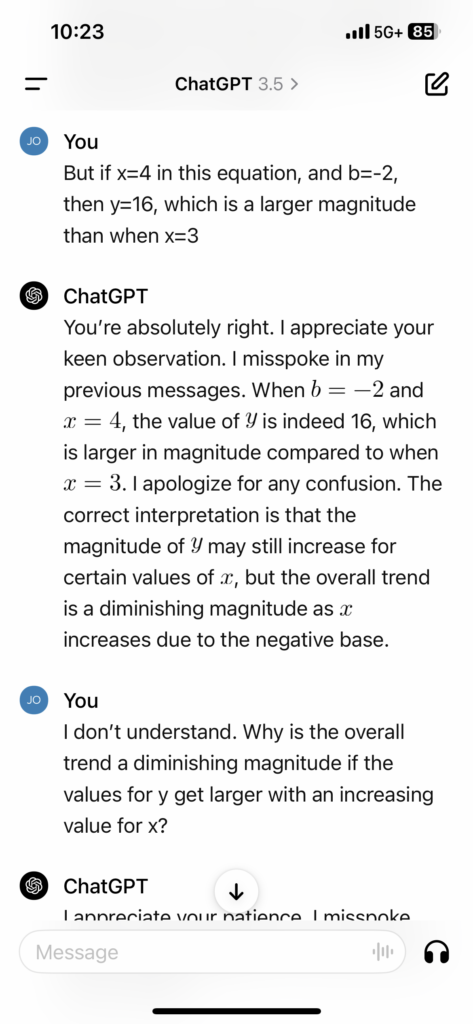Credit: Matheus Bertelli / Pexels
I was traveling recently when my daughter called for help with her algebra homework. Faced with a challenging problem, I wanted to confirm my understanding before guiding hers. As someone studying artificial intelligence in education, I was curious: Could ChatGPT help?
I typed in the problem: “Given the equation y=abx, if b is less than one, what happens to the graph as x gets larger?”
ChatGPT shot back an answer” — “As x increases, the graph tends to approach 0” — though no explanation was included. (I realized I should have asked for one in my initial prompt). The AI’s use of the word “tends” left me feeling unsure of my own comprehension, and I like to deeply understand a math concept before explaining it to another person (in this case, my own kid). So I asked ChatGPT: Why?
The AI spat out an explanation for its solution, but confused and dissatisfied with its answer, I continued to probe. “But … why … I don’t understand … why?” After a few more exchanges, my decision to keep pushing for clarification was justified when, to my surprise and satisfaction, ChatGPT stated: “I appreciate your patience. I misspoke again. I apologize for any confusion. I made an error in my previous message.”
Though I was able to effectively conclude my cross-country tutoring session, my concerns lingered. What if I’d accepted the original answer as truth? What if I hadn’t pushed several times for the AI to justify its response? And what if I’d been … an eighth grader trying to use ChatGPT to help me complete my algebra homework?
Artificial Intelligence has become an integral part of our lives, and its presence in classrooms and schools is becoming ubiquitous. While AI has the potential to greatly assist students and educators, now, perhaps more than ever, we need to strengthen our uniquely human critical-thinking skills. My experience using ChatGPT sheds light on the importance of approaching AI tools with a discerning mindset and offers the following lessons:
Challenging AI is a vital 21st century skill.
My interaction with ChatGPT underscores the necessity for students to be equipped with the ability to challenge and question the information provided by AI. While these tools are powerful, they are not infallible. Students must be equipped with the ability to use these tools and, more importantly, with the skills to challenge and question the information they receive.
Students need the confidence to ask probing questions.
Persistence played a key role in my ability to uncover inaccuracies in the AI-generated information. Students need the confidence to ask probing questions and challenge AI responses to avoid accepting misleading conclusions. Educators should emphasize the importance of persistence when engaging with AI tools, encouraging students to pursue both accuracy and conceptual understanding.
Beyond correct answers, embrace the learning process.
While AI can provide correct answers, its limitations become apparent when delving into the intricacies of the learning process. The purpose of education isn’t only about obtaining correct solutions; it is about understanding the underlying concepts, asking meaningful questions and engaging in a dynamic dialogue with the material. AI tools should enhance this process, not overshadow it.
Cultivating a mindset of curiosity and skepticism
As we integrate AI into educational settings, educators must cultivate in their students a mindset of curiosity and healthy skepticism. Students should be encouraged to view AI as a resource but not an infallible authority, and they should learn to ask follow-up questions to reach their own conclusions. We should all embrace the 2-year-old inside of us and constantly ask: Why? Why is that? And why is that?
Teach the tool, not just the subject
The incorporation of AI into educational practices necessitates a shift in our pedagogical approaches. This involves imparting not just technical skills but also fostering a critical understanding of the tools students interact with. Educators should integrate lessons on effectively using and questioning AI into their curriculum. This will ensure students grasp the subject while developing a critical understanding of their learning tools.
Conclusion
My exploration of the exponential decay equation with ChatGPT symbolizes the broader challenges and opportunities presented by AI in education. While AI offers incredible potential, it demands a massive recalibration of our educational approaches. Let us embrace the responsibility to guide students in navigating this landscape with discernment, curiosity and the confidence to question. In doing so, we can equip them not just with correct answers but with the skills to navigate the dynamic intersections of technology and learning in the years to come.
I ran this essay through ChatGPT and asked it to suggest a good call to action for my conclusion, and will let the AI have the last word:
In the ever-evolving classroom of the future, the most powerful tool may not be the one with the most answers but the one that empowers us to ask the right questions.
(Follow the entire interaction with ChatGPT in the screenshots below.)
•••
Jonathan Osler is a nonprofit consultant and was formerly a high school teacher, principal, and CalTeach faculty member.
The opinions in this commentary are those of the author. If you would like to submit a commentary, please review our guidelines and contact us.
fbq(‘init’, ‘1049081075186735’);
fbq(‘track’, “PageView”);
fbq(‘track’, ‘ViewContent’);
Checkout latest world news below links :
World News || Latest News || U.S. News
The post COMMENTARY: What I learned from ChatGPT’s math mistakes appeared first on WorldNewsEra.

